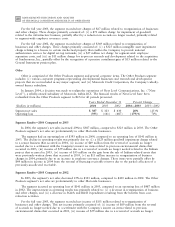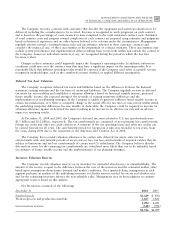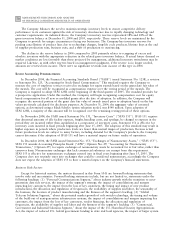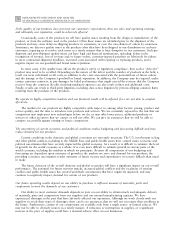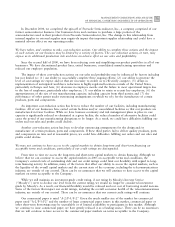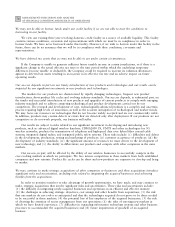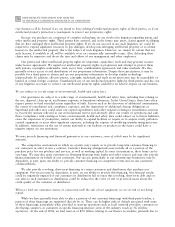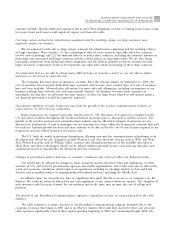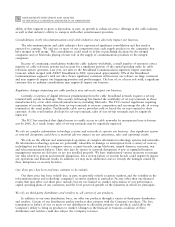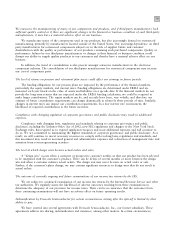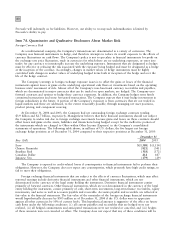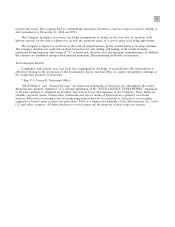Motorola 2004 Annual Report Download - page 81
Download and view the complete annual report
Please find page 81 of the 2004 Motorola annual report below. You can navigate through the pages in the report by either clicking on the pages listed below, or by using the keyword search tool below to find specific information within the annual report.
73
MANAGEMENT'S DISCUSSION AND ANALYSIS
OF FINANCIAL CONDITION AND RESULTS OF OPERATIONS
In December 2004, we completed the spin-oÅ of Freescale Semiconductor, Inc., a company comprised of our
former semiconductor business. Our businesses have and continue to purchase a large portion of the
semiconductors used in their products from Freescale Semiconductor, Inc. The change in this relationship from
internal supplier to external supplier may negatively impact this important supplier relationship and could have a
material adverse eÅect on our operating results.
We have taken, and continue to take, cost-reduction actions. Our ability to complete these actions and the impact
of such actions on our business may be limited by a variety of factors. The cost reduction actions, in turn, may
expose us to additional production risk and have an adverse eÅect on our sales and proÑtability.
Since the second half of 2000, we have been reducing costs and simplifying our product portfolios in all of our
businesses. We have discontinued product lines, exited businesses, consolidated manufacturing operations and
reduced our employee population.
The impact of these cost-reduction actions on our sales and proÑtability may be inÖuenced by factors including
but not limited to: (1) our ability to successfully complete these ongoing eÅorts; (2) our ability to generate the
level of cost savings we expect and/or that are necessary to enable us to eÅectively compete; (3) delays in
implementation of anticipated workforce reductions in highly-regulated locations outside of the United States,
particularly in Europe and Asia; (4) decreases in employee morale and the failure to meet operational targets due
to the loss of employees, particularly sales employees; (5) our ability to retain or recruit key employees; (6) the
appropriateness of the size of our manufacturing capacity, including capacity from third parties; and (7) the
performance of other parties under outsourcing arrangements on which we rely for the manufacture of certain
products, parts and components.
An important cost-reduction action has been to reduce the number of our facilities, including manufacturing
facilities. All of our businesses have exited certain facilities and/or consolidated facilities so that our products are
manufactured in fewer facilities. While we have business continuity and risk management plans in place in case
capacity is signiÑcantly reduced or eliminated at a given facility, the reduced number of alternative facilities could
cause the period of any manufacturing disruptions to be longer. As a result, we could have diÇculties fulÑlling our
orders and our sales and proÑts could decline.
Another cost-reduction action has been to develop outsourcing arrangements for the design and/or
manufacture of certain products, parts and components. If these third parties fail to deliver quality products, parts
and components on time and at reasonable prices, we could have diÇculties fulÑlling our orders and our sales and
proÑts could decline.
We may not continue to have access to the capital markets to obtain long-term and short-term Ñnancing on
acceptable terms and conditions, particularly if our credit ratings are downgraded.
From time to time we access the long-term and short-term capital markets to obtain Ñnancing. Although we
believe that we can continue to access the capital markets in 2005 on acceptable terms and conditions, the
Company's current levels of outstanding debt and our credit ratings could limit our Öexibility with regard to long-
term Ñnancing activity. In addition, many of the factors that aÅect our ability to access the capital markets, such as
the liquidity of the overall capital markets and the current state of the economy, including the telecommunications
industry, are outside of our control. There can be no assurances that we will continue to have access to the capital
markets on terms acceptable to the Company.
While we still maintain an investment grade credit rating, if our rating by Moody's Investor Service
(""Moody's'') were to decline one level from the current rating, we would no longer be considered investment
grade by Moody's. As a result, our Ñnancial Öexibility would be reduced and our cost of borrowing would increase.
Some of the factors that impact our credit ratings, including the overall economic health of the telecommunications
industry, are outside of our control. There can be no assurances that our current credit ratings will continue.
Our commercial paper is rated ""A-2/P-3/F-2.'' Given the much smaller size of the market for commercial
paper rated ""A-2/P-3/F2'' and the number of large commercial paper issuers in this market, commercial paper or
other short-term borrowings may be unavailable or of limited availability to participants in this market. Although
we continue to issue commercial paper, we have greatly reduced it as a funding source. There can be no assurances
that we will continue to have access to the commercial paper markets on terms acceptable to the Company.



